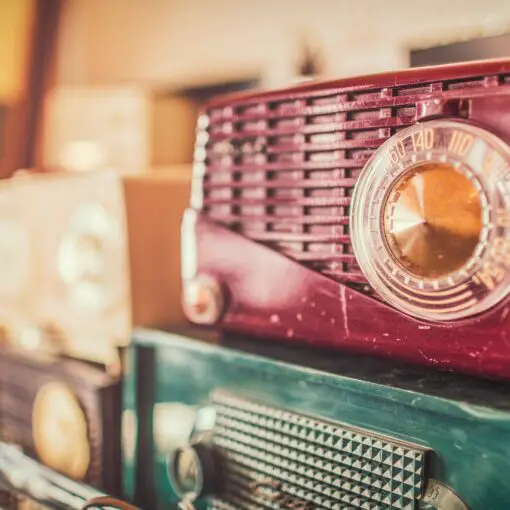Ever watched the infamous Netflix show Stranger Things where four of the kids used a ham radio to communicate with each other? For them, it was no less than a wireless phone or internet connection. What if we tell you that you can make one such ham radio for yourself and that too using some simple components? Sounds exciting… Right? In this guide, we will tell how a ham radio works and how to make one from scratch. It’s going to be super interesting, so stick to the end!
What is Ham Radio?
So, what exactly is a ham radio?
A ham radio which is also known as amateur radio is one of the most fascinating hobbies these days. Today, there are more than a million ham radios in the world, this figure is enough to sense the huge popularity of this concept. A typical radio ham consists of a variety of equipment such as a transmitter, a receiver, antennas, and a few others.
What Are The Aspects Of Ham Radio Basics?
One of the biggest advantages of amateur radio is that it offers plenty of things to do within this exciting hobby. The ham radio hobby includes several different elements, so you can keep trying and perusing each element at a time throughout your life without getting bored.
Below are some of the application areas of ham radio :
DXing / HF Operation
This part is loved by a majority of radio amateurs. They enjoy communicating with DX stations all across the globe. You can communicate with the other ham radios in any corner of the world, it can be in the middle of a desert, on an island, or just another radio amateur on the other end of your same town. You can do all this by sitting in your armchair. Even in the era of technology, it feels like an achievement to be able to communicate with other ham radio without using any advanced equipment in the middle of two stations. Simply put, you’re communicating over the air!
UHF / VHF And Microwaves :
Although most Hams are familiar with the short frequency waves, there are many other activities you can perform on high wave-bands. There are plenty of radio-frequency spaces in the microwave region itself and these allocations offer a great and interesting scope of this hobby. The UHF and VHF wave bands offer a great medium for local communication. Moreover, many countries have their network of repeaters that allows one to make contacts or simply communicate with the poor areas that are located at greater distances.
Make New Radio Buddies :
Perhaps the biggest aspect of using ham radio is the opportunity it provides to make new friends from different corners of the world. You can not only talk to them in the air, but you also take your friendship further by meeting each other on different occasions. If you already don’t know, there are many ham radio clubs and fests that organize meet and greet for different ham radio friends. Even if your ham radio buddy resides in a different country, you can meet him at the international radio meetings that are organized frequently.
Data Communication :
Some ham radio amateurs enjoy connecting their computers with their radio equipment. There are many ways in which you can link your PC to your gear and use it for performing tasks such as monitoring the stations you’re connected with or predicting the propagation over the air etc. By using your computer as an interface as well as a controller, you can send messages over a network of mailboxes that can be received by the other end-users at the time they log in.
For Research Studies :
There are multiple instances where ham radio enthusiasts have made significant contributions to valuable research studies. This is especially true in the area of radio propagation. A great number of radio amateurs communicating over the air would have meant large amounts of data that can be collected and used in different fields.
Emergency Situations :
Ham radios can also be used for serving society. They are great in providing emergency communication support to either rescue the people or to help them in connecting with the essential services during a disaster. There are many instances where an amateur radio was the only form of communication available for people hit by a natural disaster.
Apart from the above-mentioned aspects, ham radio can also become a much rewarding career choice. There are examples of individuals who’ve started taking interest in ham radio as a hobby when they were kids and now having thriving careers in the field of electronics and radio communication. This hobby offers plenty of challenges and experimentation which attracts many employers as it makes the candidate different from others.
The Amateur Radio Spectrum


Similar to the other wireless technologies, ham radios are based on the concept of electromagnetic waves. They use EM radiations to send their voices, digital data, and Morse code across the globe with the help of basic equipment such as antennas, transmitters, and receivers. This EM radiation propagates in the form of sinusoidal waves. So, the particular frequency and wavelength of these waves are used to determine the type of signal your ham radio is working on. The electromagnetic radiations can be further broken down into a wave spectrum given below. This spectrum is stated in the order of increasing frequencies and decreasing wavelengths of radio waves, microwaves, visible light, infrared, x-rays, UV rays, and gamma rays.
Ham radio operates only in the radio wave spectrum out of these categories. The radio wave spectrum is solely known for long wavelengths ranging from 0.04in and goes as high as 62 miles. Further, the radio frequencies can be again broken down into a different radio frequency spectrum.
In a radio frequency spectrum, there are plenty of devices that share the common space. FCC has reserved different frequency bands for different radio technologies and applications. For instance, satellite communications are operated in the EHF or Extremely High-Frequency Band and maritime radio communications are operated in the VLF or very low-frequency bands.
In the case of ham radios, FCC has allocated a set of frequencies ranging from 1.6MHz with AM band and goes up to 1240MHz. This range involves two bands, Very High Frequency or VHF band and Ultra High-Frequency Band or UHF. Each of these bands has its own set of positives and negatives. Let’s discuss these in detail!
Very High Frequency (VHF)
Very High-Frequency waves reside in the range between 30 MHz to 300MHz. However, for the ham radio, a range of 144 to 148MHz is reserved.
It is used in building a simple communication system. This system will allow you to communicate over two ham radio stations via a single line of sight. VHF band is mainly known for the reliability it offers. Other advantages include less noise distraction. For these reasons, VHF is considered the best choice for radio hams.
In a system of radio hams operating over VHF space, the operators mostly take advantage of repeaters that are installed around the region by radio clubs. These antennas or repeaters receive and transmit the signal to and from one radio station to the other. The best part is, some of these antenna-like structures are solar-powered, so they don’t run out of power and keep the communication smooth and continuous. This feature is very useful during an emergency.
Ultra-High Frequency (UHF)
With UHF, we enter into the radio frequency spectrum. These frequencies typically start from 300MHz and end at a whopping 3 GHz. A ham radio however needs a frequency ranging between 420MHz to 450MHz. As compared to the VHF, UHF radio waves are of much shorter wavelengths. The downside of these waves is, they can be easily interfered with by solid objects such as any building or even a human or animal body. On the positive side, UHF waves require very little bandwidth, and the signal quality offered by these waves is much better.
Ham Radio Mastery: The All-In-One Guide to Acing Your Technician Class Exam & Unlocking the World of Amateur Communication
With the guidance and support of this book, you can master the intricacies of ham radio and join the ranks of over one million ham radio operators worldwide
Ham Radio Basics: Make Your Own Ham Radio From Scratch
Now that we have discussed pretty much everything about the ham radios, from the ham radio basics to their advantages and applications, you might be interested in making your own functional radio. The good thing is, you can easily do that. And if you think that for making a radio shack you’ll need to spend thousands of dollars, you’re wrong. These days, there are plenty of cheap ham radio kits available that allow the enthusiasts to make their own radio by spending as little as $30. You can easily order the components for designing a radio shack online.
Below are the main components you need to invest in :
Receiver
A receiver is an important component of a radio shack that allows you to listen to a variety of radio bands. It usually comes as a hand-held or desktop machine. These days, some advanced receivers come with a memory module using which you can save your desired frequencies.
Transceiver
You can also invest in a good quality and functional transmitter. Its main job is to combine the working of both the receiver and the transmitter. The advantage is, you don’t have to invest in a transmitter and receiver separately, just one transmitter box will do the job. You don’t have to purchase a highly advanced transmitter for your DIY ham radio, a basic single-band model of about 2 to 3 meters is enough. But keep in mind, if you want to upgrade your radio and its license, you’ll have to invest in a dual or triple band transceiver.
Antenna
If you’re planning to operate in your backyard or any other outdoor space, you can invest in a set of antennas. They usually come in two categories, directional and omnidirectional. While the latter one transmits the signal in all directions, the directional antennas send a signal in one direction only. You can also invest in mobile antennas that you can install on your vehicle to boost your signal strength while operating on the road.
Antennas are generally available in a wide range of shapes and sizes. You can buy a decent one that falls under your budget.
And that’s all you need to design your DIY ham radio. By putting together these components, you can easily get started with radio communication.
Apart from these key components, you’ll also need a few other things such as cables, microphones and of course power supply. You can check out the assembling of these components on tutorials that are available online.
Ham Radio Basics: How To Get The Ham Radio License
Even after setting up your DIY ham radio shack, you can’t operate until you have a license. To operate the ham legally, the first step is to get a license test. This test will cover the basic radio rules and knowledge, electronics theory, and some other necessary regulations. There are mainly three types of license that are available :
Technician
This license is mainly suitable for beginners who’ve just started with their amateur radio hobby. This test comes with 35 questions that are based on basic knowledge about electronics theory, radio rules, and regulations, safety rules, etc. Once you pass the technician test, you’ll be able to operate your radio legally in the UHF, VHF, and microwave bands.
General
A general license offers you all the benefits provided by the Technician license plus the ability to operate your ham radio in the High Frequency or HF band.
Extra
Finally, there is the Extra license that is recommended for the professionals and those who are into some serious research or study. This test comes with 700 questions that are about deep knowledge and regulations. On passing this test, you’ll get the combined benefits of both Technician and General license plus allows you to operate your radio in exclusive bands.
And it’s a wrap!
Ham radio is a great hobby to start with. Being able to communicate over the air without any equipment or technology is very exciting. This is why more and more people are attracted to this hobby. This guide is compiled with everything you need to master ham radio basics and get started. We hope it helps you.







3 thoughts on “Ham radio Basics: A Complete Beginners Guide To Amateur Radio”
Thank you for your article. I’m a retired LEO/Sgt. of 28 years, and with the way our Republic is heading, myself and a handful of other retirees are very concerned! Our speech and communications are under assault by big tech, and I am eager to learn mire about Ham radio and what it offers for an off the grid type setup. Any time and assistance you offer will be greatly appreciated.
Again, thank you for being out there for rookies like me, who are looking to find ways to communicate and survive if thrn need arises.
Donnie
Thank you Donnie. Im glad you enjoyed the article. Keep an eye out for more articles in the coming weeks.
Here is another good article for beginners:
https://theprepared.com/survival-skills/guides/beginners-guide-amateur-ham-radio-preppers/